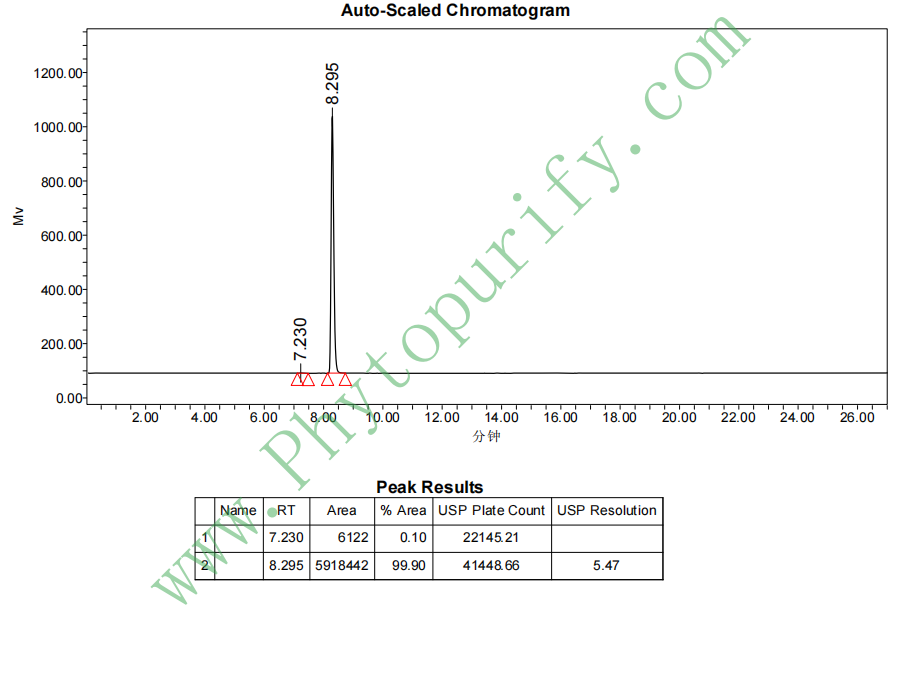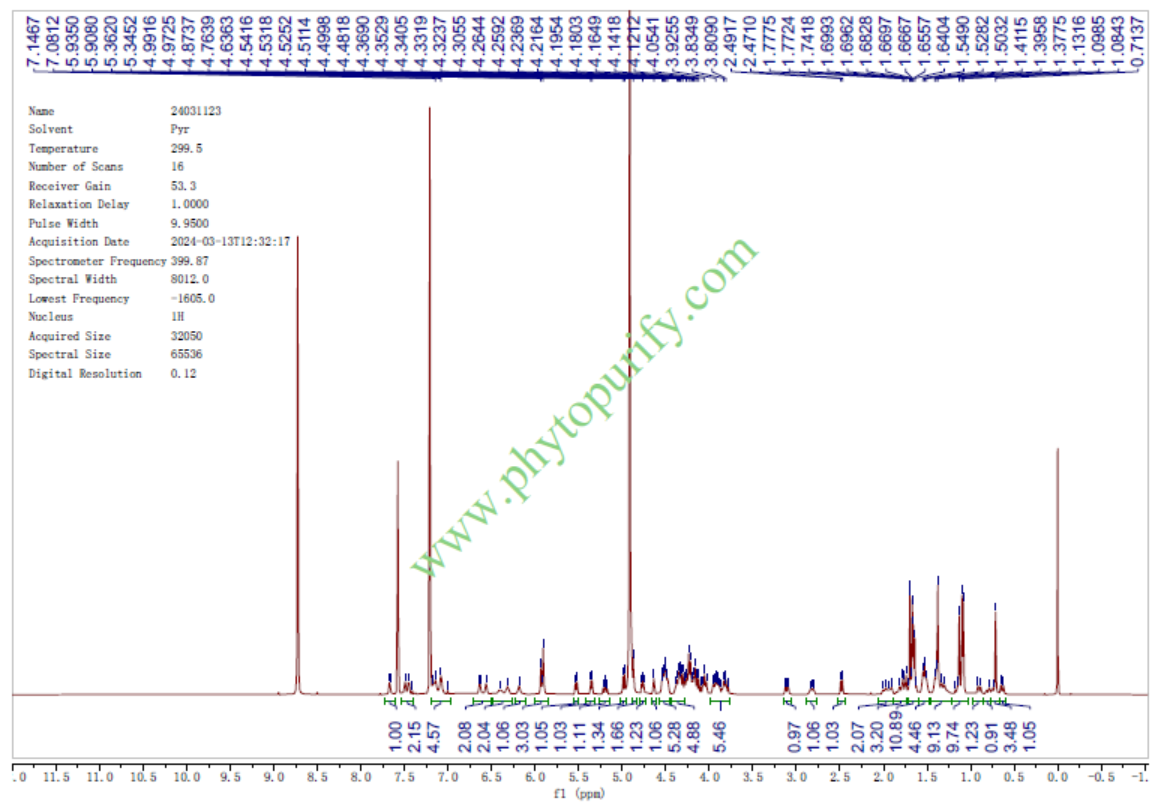
Jujuboside ACAS No.:55466-04-1
|
||||||||||
 |
|
|
||||||||

| Catalogue No.: | BP0813 |
| Formula: | C58H94O26 |
| Mol Weight: | 1207.36 |
Product name: Jujuboside A
Synonym name:
Catalogue No.: BP0813
Cas No.: 55466-04-1
Formula: C58H94O26
Mol Weight: 1207.36
Botanical Source: Ziziphispinosae semen
Physical Description:
Type of Compound: Triterpenoids
Purity: 95%~99%
Analysis Method: HPLC-DAD or/and HPLC-ELSD
Identification Method: Mass, NMR
Packing: Brown vial or HDPE plastic bottle
Storage: Store in a well closed container, protected from air and light. Put into refrigerate or freeze for long term storage.
The product could be supplied from milligrams to grams
Inquire for bulk scale.
Description:
Jujuboside A, a neuroprotective agent, can ameliorates behavioral disorders of the dementia mouse model induced by Aβ1-42. It possesses sedative , anticonvulsant , antianxiety, anti-proliferation, antioxidant, and anti-inflammatory effects, it can notably reduce the damage cause by ISO via promoting the phosphorylation of PI3K, Akt, and mTOR and inhibiting LC3 conversion, which may be a potential choice for the treatment of heart diseases. Jujuboside A can inhibit gamma aminobutyric acid type A receptor, and the hyperactivity of hippocampal CAl area induced by penicillin sodium.
References:
Evid Based Complement Alternat Med. 2016;2016:9593716.
Jujuboside A Protects H9C2 Cells from Isoproterenol-Induced Injury via Activating PI3K/Akt/mTOR Signaling Pathway.
Jujuboside A is a kind of the saponins isolated from the seeds of Ziziphus jujuba, which possesses multiple biological effects, such as antianxiety, antioxidant, and anti-inflammatory effects; however, its mediatory effect on isoproterenol-stimulated cardiomyocytes has not been investigated yet. In this study, we tried to detect the protective effect and potential mechanism of JUA on ISO-induced cardiomyocytes injury.
METHODS AND RESULTS:
H9C2 cells were treated with ISO to induce cell damage. Cells were pretreated with JUA to investigate the effects on the cell viability, morphological changes, light chain 3 conversion, and the activation of PI3K/Akt/mTOR signaling pathway. Results showed that ISO significantly inhibited the cell viability in a time- and dose-dependent manner. JUA pretreatment could reverse the reduction of cell viability and better the injury of H9C2 cells induced by ISO. Western blot analysis showed that JUA could accelerate the phosphorylation of PI3K, Akt, and mTOR. Results also indicated that JUA could significantly decrease the ratio of microtubule-associated protein LC3-II/I in H9C2 cells.
CONCLUSIONS:
Taken together, our research showed that JUA could notably reduce the damage cause by ISO via promoting the phosphorylation of PI3K, Akt, and mTOR and inhibiting LC3 conversion, which may be a potential choice for the treatment of heart diseases.
Northwest Pharmaceutical Journal, 2013, 28(3):281-4.
Inhibitory effect of jujuboside A on proliferation of human normal liver cells,hepatic stellate cells and human hepatoma cells by MTT assay
To observe the effect of different mass concentration of Jujuboside A(JuA)on proliferation of human normal liver cells LO2,rat hepatic stellate cells and human hepatoma cells SMMC-7721,respectively.
METHODS AND RESULTS:
The three cells were respectively divided into control group and six experimental groups which had different mass concentration of JuA.MTT assay was used to detect the activeness of cells.Effective mass concentration range and optimal dosing time were obtained by inhibition ratio.Results There was no difference in inhibitory effect of JuA on proliferation of human normal liver cells LO2and rat hepatic stellate cells(P0.05).But for human hepatoma cells SMMC-7721,there was a significant difference in inhibitory effect of JuA on proliferation(P0.05).The effective mass concentration was ranged from 5to 80μg.mL-1,the optimal dosing time was 48hand the IC50was 1.996μg.mL-1.
CONCLUSIONS:
JuA has a potential anti-hepatoma activity but has no toxicity to human normal liver cells LO2and rat hepatic stellate cells.
Eur J Pharmacol. 2014 Sep 5;738:206-13.
Jujuboside A, a neuroprotective agent from semen Ziziphi Spinosae ameliorates behavioral disorders of the dementia mouse model induced by Aβ 1-42.
Semen Ziziphi Spinosae (SZS) has been used as a hypnotic-sedative medicine for thousands of years. Recently, SZS has also shown notable neuroprotective activities via anti-oxidative and anti-inflammatory effects in dementia animals. Jujuboside A (JuA), isolated from SZS, has been proved to be a major hypnotic-sedative component of SZS.
METHODS AND RESULTS:
In the present study, we firstly evaluated the effects of intracerebroventricular (ICV) injection of JuA (0.02 and 0.2mg/kg) for five consecutive days on cognitive impairment induced by ICV injection of Aβ 1-42. The results showed that ICV treatment with JuA significantly mitigated learning and memory impairment in mice induced by Aβ 1-42 as measured by the Y-maze, active avoidance and Morris water maze. Furthermore, ICV treatment with JuA reduced the level of Aβ 1-42 in hippocampus, significantly inhibited the activities of acetylcholinesterase (AChE) and NO, and decreased the amount of the increased malondialdehyde (MDA) in the hippocampus and cerebral cortex of mice treated with ICV injection of Aβ 1-42. Shrinkage of nuclei, swollen and eccentrically dispersed neuronal bodies were observed in hippocampus of AD mice induced by Aβ 1-42, however, JuA noticeably improved the histopathological damage.
CONCLUSIONS:
Cumulatively, the present study indicates that JuA may serve as a potential therapeutic agent for the treatment of Alzheimer' disease.
HPLC of Jujuboside A

HNMR of Jujuboside A
